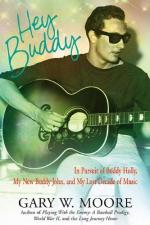|
This section contains 3,106 words (approx. 11 pages at 300 words per page) |

|
SOURCE: "Not Fade Away: Buddy Holly and the Making of an American Legend," in Journal of Popular Culture, Vol. 15, No. 4, Spring, 1982, pp. 75-80.
In the following essay, Aquila examines the endurance of Holly's reputation as a songwriter and his status as a major figure in popular American culture.
February 3, 1959 is for many rock and roll fans a day of infamy. Don McLean, in his 1971 recording "American Pie," referred to it as "the day the music died." On that day Buddy Holly, a twenty-three-year-old rock star, was killed in the crash of a chartered single-engine airplane. Two other rock stars, Ritchie Valens and J.P. Richardson (The Big Bopper), also died in the crash. But of the three, Holly's death had the greatest impact on the music world.
Between 1957 and 1959, Buddy Holly achieved artistic and commercial success as both a solo artist and lead singer for the Crickets. Holly's...
|
This section contains 3,106 words (approx. 11 pages at 300 words per page) |

|


